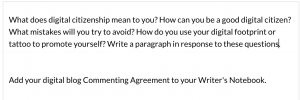Peer Feedback on Blogs
Modeling Feedback Impacts the Ability of Students to Give Each Other Better Feedback
One of the benefits of modeling great feedback throughout a school year is the improvement students make in giving feedback to each other. To help students, I use an E-Q-S model with them starting at the beginning of the year. We use this same feedback frame for all genres of writing and it is modeled regularly for students to be effective in the writing community.
E=Encourage
Students are asked to encourage the other writer. What did the writer do well? What did you like about the written piece? What stands out? How did you see the writer use the genre effectively? What should the writer do again in another piece?
Q=Question
Students are asked to politely question the other writer’s craft. For example, why did you use a certain word, provide a fact, use a source, give a certain description, or something else they are curious about. We also encourage questions for helping the writer add more. What else could you add in a certain spot? How can you describe the setting more? What am I suppose to see in my mind in this spot? How do you think you could improve this piece?
S=Suggest
Students are taught to use what they know about writing to help each other improve. We want to make suggestions not demands for other writers. However, sometimes we might find a conventions error more easily in another person’s work. Students may offer better words to make the writing sparkle. An idea for more description can be given. Conventions can be easy suggestions or spots to circle and ask the teacher about. Overall, writers suggest ideas that could enhance the piece, but the writer decides if the changes are ones he/she wants to make.
Digital Tattoo

Discussion Board Assignment on Canvas in August
I used to tell students that they had a digital footprint on each other’s blogs. However, I have found that calling it a tattoo is more effective. A footprint may fade with time, but a tatoo is more permanent and is less likely to change. At the start of the year, we did a digital citizenship agreement and discussion board on Canvas. There was also a paper agreement that was added to the interactive composition notebook we use in the classroom. By making this formal, students had a better understanding of expectations and could practice right away in the Canvas discussion board on the topic of digital citizenship.
 We spent time in the classroom working on what positive feedback looks like on a blog and how it is available for others to see. Using blog comments is a wonderful way to work on digital citizenship in the classroom. The students were provided with a rubric for blog comments on Canvas. As the teacher, in Kidblog, I can control the comment submissions. The teacher is able to set up approval for all comments which allows for successful growth for students. If someone gave a comment that I felt was not meeting the standard while we were still in the classroom, I could use it as a teachable moment by having a conversation with the student. Fortunately, by the time we were on eLearning the students were proficient in leaving each other comments. Seeing their growth in this area was actually a highlight of eLearning!
We spent time in the classroom working on what positive feedback looks like on a blog and how it is available for others to see. Using blog comments is a wonderful way to work on digital citizenship in the classroom. The students were provided with a rubric for blog comments on Canvas. As the teacher, in Kidblog, I can control the comment submissions. The teacher is able to set up approval for all comments which allows for successful growth for students. If someone gave a comment that I felt was not meeting the standard while we were still in the classroom, I could use it as a teachable moment by having a conversation with the student. Fortunately, by the time we were on eLearning the students were proficient in leaving each other comments. Seeing their growth in this area was actually a highlight of eLearning!

During eLearning, I continued to model what the expectations for comments were so that students could be successful with their feedback.
So proud of these Ss and their feedback to each other’s blogs. Just look at their kindness! Thankful for their following of the rubric and their digital citizenship with each other. Way to go! @SandCreekInt #elearning2020 #inthistogether pic.twitter.com/8e0Fr01Lth
— Laura Christie (@MrsChristie21) April 29, 2020
Commenting Tips for Students |
|---|
| Think before you comment. |
| Say something meaningful. |
| Be polite. |
| Write comments that reflect you in a positive way. |
| Only write something you would say in person. |
| Stay on topic. |
| Be clear. |
| Avoid sarcasm. |
| Be concise. |
| Assume everyone can read your comment. |